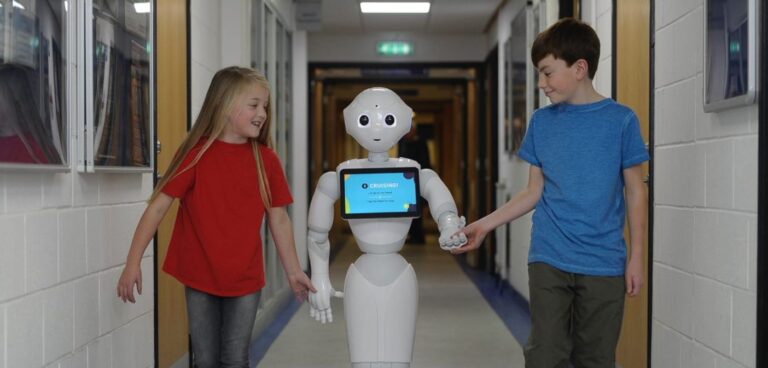Industry and academic partners around the world need to share best practice of how to engage the public in research and innovation writes Professor Yvan Petillot, joint academic lead for the National Robotarium and director of the Offshore Robotics for Certification of Assets (ORCA) Hub…
The pandemic has ignited a widespread interest in robotic solutions across a diverse range of sectors and disciplines. Technological advances in intelligent sensing and telepresence, for example, have captured the attention of healthcare practitioners as key services moved rapidly online. Exploring how a patient’s physical and cognitive health can be assessed remotely has highlighted a range of benefits for health, from accessing expertise from all over the globe to reducing pressure on overstretched services.
Research from the Industrial Federation on Robotics (IFR) shows that the use of robotics in UK-based factories has also risen by 6%. Internationally, however, the UK has one of the lowest trust rates when asked to consider the role that robotics could play in British society.
As a result, research is being conducted by the National Robotarium, alongside other partners, to help both industry and the public to understand more about how technological advances could support and complement people in their roles and daily lives.
Changing the template for robotics research
Professor Helen Hastie from Heriot-Watt University and Professor Subramanian Ramamoorthy from the University of Edinburgh, leading academics in the National Robotarium, are spearheading two multimillion-pound projects dedicated to researching trustworthy autonomous systems.
Each project represents a £3m investment and will be delivered in partnership with other institutions. Part of the UKRI Trustworthy Autonomous Systems Programme, this research brings together expertise in robotics, cognitive science and psychology to explore human trust, governance and regulation. While autonomous systems are already deployed in industry, their use is largely limited to controlled settings, such as on automated production lines. These systems can struggle when the task becomes more complex or the environment is uncontrolled.
The research explores solutions to manage trust in autonomous systems, covering scenarios that require interaction with humans such as self-driving cars, autonomous wheelchairs or ‘cobots’ in the workforce. The project group’s work will help design the autonomous systems of the future, ensuring they are widely used and accepted in a variety of industry-relevant applications. The team will perform foundational research on how humans, robots and autonomous systems can work together by building a shared reality through human-robot interaction.
Why is trust essential?
Without trust at the centre of robotics research, adoption will face numerous barriers. Our strategic project the ORCA Hub is developing new technologies in close partnership with industry to help make tasks in hazardous environments safer. Creating robotic solutions to carry out maintenance and inspection of offshore energy assets, these innovations will require human operators to guide and support the systems. Only by embedding the appropriate level of trust at the core of the project will we ensure greater acceptance, usability and, ultimately, adoption in the offshore energy sector.
Educating future generations
To increase public trust, future generations will be key. Roboticists should consider opening their facilities to the public and inviting them to both witness and inform their innovations. By allowing the public to interact with robots more regularly, it will help mitigate feelings of hesitancy. Researchers should be mindful that sentiments around robotics technologies and their place in society will not change overnight. Creating a hub where an ongoing dialogue can develop is essential to allow an evolution of opinion and ideas.
The National Robotarium recently launched a schools competition aimed at engaging primary-aged pupils in robotics and AI research. Over 1,000 primary school pupils from the facility’s local area suggested a name for the centre’s new robot dog. This initiative was the first activity in a wider series designed to educate young people about robotics and AI and inspire young people to consider a robotics career. We look forward to the completion of our Education Hub, which will form part of the new National Robotarium building opening later this year on Heriot-Watt University’s Edinburgh campus.
The Hub will be used to deliver educational workshops and interactive displays, bringing research to life and demonstrating the wide ranging applications of robotic and AI technologies. We believe that providing future generations with the opportunity and the skills to explore this field from a young age will help shift public perceptions going forward.
Presenting on the global stage
In March, my colleague Professor Oliver Lemon will be presenting in Dubai. Professor Lemon’s team is developing technology to use speech, gesture, motion, and facial expressions to help robots interact naturally with humans. This pioneering AI research is paving the way for more rapid and effective conversational and natural language communication between people and autonomous systems.
Learning from international examples
Interest in robotic solutions varies enormously from region to region. Asia Pacific currently accounts for close to 70% of the world’s total industrial robot usage while Japan dominates robot manufacturing with 47% of the market share.
In Asia, younger generations are encouraged to engage with robotics and the technological practises used in their creation. In 2020, computer programming was added as a compulsory subject to Japan’s school curriculum, with education authorities in the country highlighting the value of learning to code from an early age. This is an aspiration for the UK’s curriculum as we strive to remain competitive globally.
It’s positive to see industry and academic partners around the world embracing key learnings and sharing best practice about how to engage the public in research and innovation. By sharing these strategies, we will provide researchers both today and in the future with a stronger foundation for exploration. Encouraging societies to be both open-minded and challenging about the application of robotic innovations will lead to stronger and more valuable research – and ultimately that will benefit us all.









